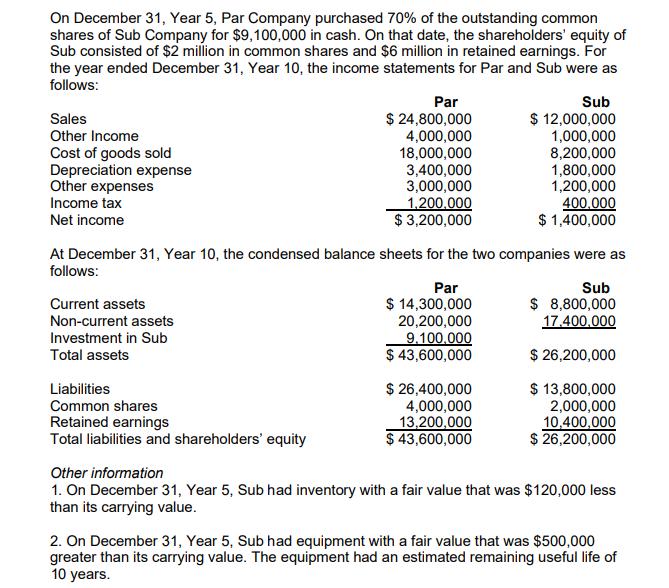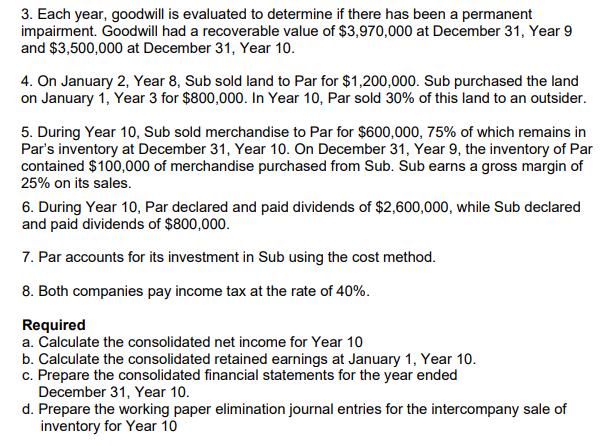Answered step by step
Verified Expert Solution
Question
1 Approved Answer
On December 31, Year 5, Par Company purchased 70% of the outstanding common shares of Sub Company for $9,100,000 in cash. On that date,


On December 31, Year 5, Par Company purchased 70% of the outstanding common shares of Sub Company for $9,100,000 in cash. On that date, the shareholders' equity of Sub consisted of $2 million in common shares and $6 million in retained earnings. For the year ended December 31, Year 10, the income statements for Par and Sub were as follows: Sales Other Income Cost of goods sold Depreciation expense Other expenses Income tax Net income Current assets Non-current assets Investment in Sub Total assets Par $ 24,800,000 4,000,000 Liabilities Common shares Retained earnings Total liabilities and shareholders' equity 18,000,000 3,400,000 3,000,000 1,200,000 $3,200,000 At December 31, Year 10, the condensed balance sheets for the two companies were as follows: Par $ 14,300,000 20,200,000 9.100.000 $ 43,600,000 Sub $ 12,000,000 1,000,000 8,200,000 1,800,000 1,200,000 400,000 $ 1,400,000 $ 26,400,000 4,000,000 13,200,000 $ 43,600,000 Sub $ 8,800,000 17.400.000 $ 26,200,000 $ 13,800,000 2,000,000 10,400,000 $ 26,200,000 Other information 1. On December 31, Year 5, Sub had inventory with a fair value that was $120,000 less than its carrying value. 2. On December 31, Year 5, Sub had equipment with a fair value that was $500,000 greater than its carrying value. The equipment had an estimated remaining useful life of 10 years. 3. Each year, goodwill is evaluated to determine if there has been a permanent impairment. Goodwill had a recoverable value of $3,970,000 at December 31, Year 9 and $3,500,000 at December 31, Year 10. 4. On January 2, Year 8, Sub sold land to Par for $1,200,000. Sub purchased the land on January 1, Year 3 for $800,000. In Year 10, Par sold 30% of this land to an outsider. 5. During Year 10, Sub sold merchandise to Par for $600,000, 75% of which remains in Par's inventory at December 31, Year 10. On December 31, Year 9, the inventory of Par contained $100,000 of merchandise purchased from Sub. Sub earns a gross margin of 25% on its sales. 6. During Year 10, Par declared and paid dividends of $2,600,000, while Sub declared and paid dividends of $800,000. 7. Par accounts for its investment in Sub using the cost method. 8. Both companies pay income tax at the rate of 40%. Required a. Calculate the consolidated net income for Year 10 b. Calculate the consolidated retained earnings at January 1, Year 10. c. Prepare the consolidated financial statements for the year ended December 31, Year 10. d. Prepare the working paper elimination journal entries for the intercompany sale of inventory for Year 10
Step by Step Solution
★★★★★
3.52 Rating (166 Votes )
There are 3 Steps involved in it
Step: 1
a Calculate Consolidated Income for your l...
Get Instant Access to Expert-Tailored Solutions
See step-by-step solutions with expert insights and AI powered tools for academic success
Step: 2

Step: 3

Ace Your Homework with AI
Get the answers you need in no time with our AI-driven, step-by-step assistance
Get Started


